How to organize all of your tabs on Chrome and other browsers
All products recommended by Engadget are selected by our editorial team, independent of our parent company. Some of our stories include affiliate links. If you buy something through one of these links, we may earn an affiliate commission. All prices are correct at the time of publishing.
We’ve all been there. Maybe you were neck-deep in a work project, or you hopped too far down a Wikipedia rabbit hole, but at a certain point you looked up and realized you were drowning in a mess of browser tabs, with no clear way to put them all in order.
Thankfully, there’s a variety of features you can use to tidy up your browsing space. We’ve broken down the most helpful tab management tips and tricks for the four most popular browsers (Chrome, Edge, Safari and Firefox), from lesser-known built-in tools to some useful add-ons from third parties.
How to organize tabs in Chrome

Jeff Dunn / Engadget
Google Chrome is by far the most popular web browser in the world, but some of its built-in tab management tools may not be immediately apparent to some users. One trick is to use “tab groups,” which lets you cluster multiple tabs into groups that you can label and color-code. This makes it easier to distinguish between different topics, or simply separate work-related pages from the rest. Clicking a group’s label will collapse or expand all tabs within.
You can create a group or add tabs to an existing group by right-clicking on the one you want to move, selecting “Add tab to group,” then choosing where you want the tab to go. Alternatively, you can just click and drag a tab in or out of a group to add or remove it. All of this still works if you’ve selected multiple tabs simultaneously (which you can do by holding Ctrl on Windows, or Cmd on macOS, as you click).
If you right-click on a group’s label, you can change the name and color, ungroup all the tabs contained within it, close the group entirely or move it into a new window. You can also do the last of those by simply dragging the group label out of its current window. If you close a tab group accidentally, note that you can restore it from Chrome’s three-dot menu, hovering over History, finding the group’s name and clicking “Restore group”.

Jeff Dunn / Engadget
Regardless of whether you use tab groups, you can quickly search through all of your open tabs by using the “Search tabs” button. This is the downward-facing arrow in the top right corner of your window. You can also pull this up by hitting Ctrl + Shift + A on Windows, or Cmd + Shift + A on macOS. This will show you a tidy vertical list of all your open tabs, plus a handful that you’ve recently closed. You can close tabs directly from here as well, and the menu will break out any open tabs that are currently playing audio or video. You can also search through your open tabs directly from Chrome’s address bar. Just type “@tabs”, then hit the space bar or Tab to initiate it.
If you like to order your tabs by putting them in distinct windows, you can give each a custom name for better organization. If you have a bunch of work-related tabs in one window, for instance, you could call that one “Work”. To do this, pull up the window you want to name, right-click the empty space next to the new tab (or “+”) icon and select “Name window.”

Jeff Dunn / Engadget
From that same menu, you can also select “Bookmark all tabs” to bookmark all of your open tabs and put them in a particular folder. Hitting Ctrl/Cmd + Shift + D will bring you to this same function.
Tab management isn’t as big of a hindrance on smartphones, where you might only look at one tab at a time. Still, we’ll note that Chrome lets you create tab groups on Android by tapping the square “Switch tabs” button, then holding and dragging a particular tab over to whatever other tab you want to group it with.
That feature isn’t available on iPhones and iPads, but you can still search through open tabs by hitting the same Switch tabs button, then selecting the Search icon in the top left corner. You can also bookmark one or more open tabs from the Switch tabs menu, after pressing and holding an open tab. For multiple tabs, press Edit, then Select Tabs, check off the tabs you want to bookmark, then hit Add To… > Add to Bookmarks.
How to organize tabs in Edge
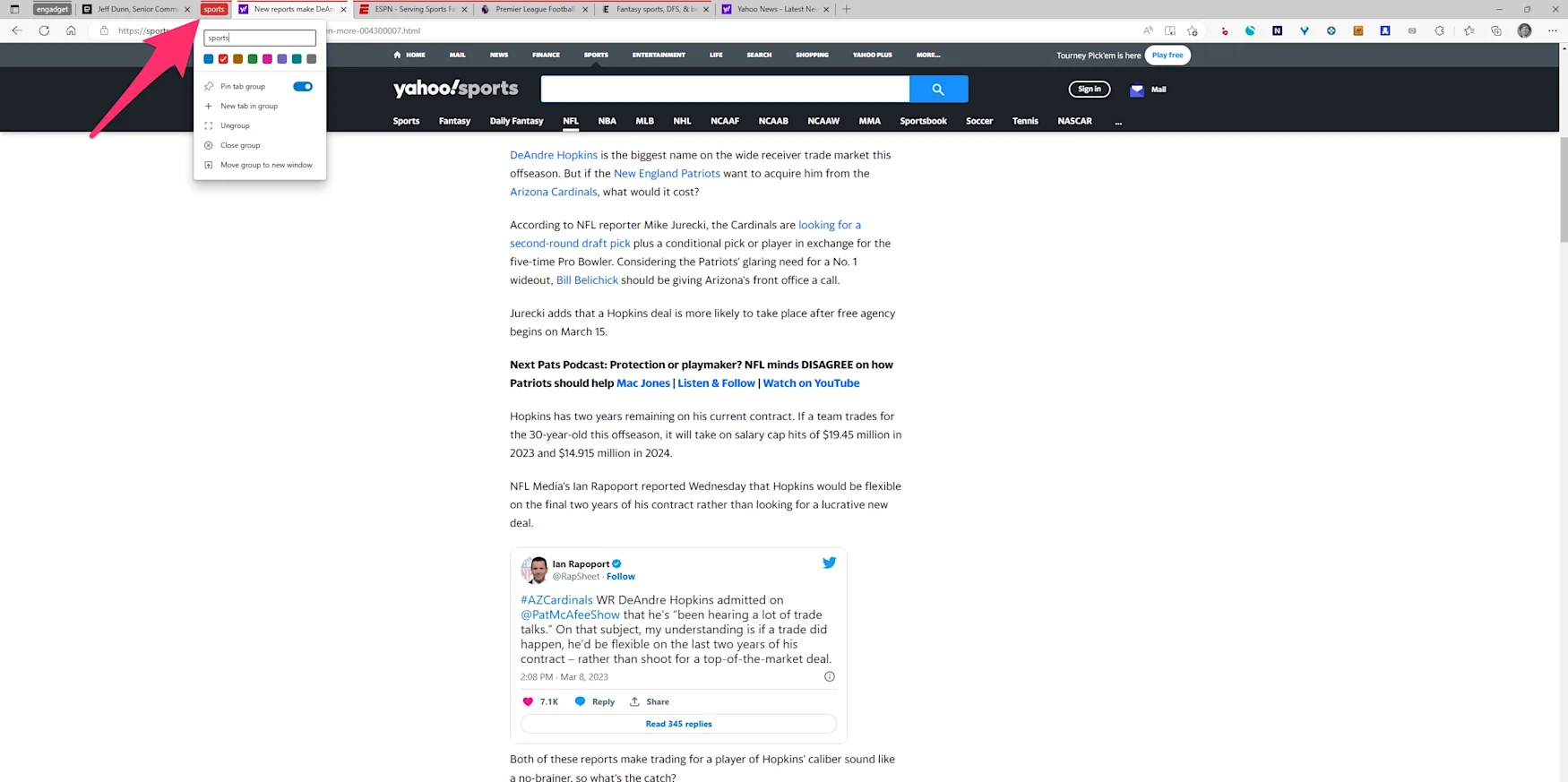
Jeff Dunn / Engadget
Microsoft Edge is built on the same codebase as Chrome, so it shouldn’t be a surprise to hear that its tab management features are similar to those found in Google’s browser. It, too, has a tab grouping feature, which works in effectively the same way: Just right-click on one or more tabs and select “Add tab(s) to group.” As with Chrome, you can give each group a custom name and color, and you can quickly collapse or expand the tabs within each group by clicking its label.
Also like Chrome, hitting Ctrl/Cmd + Shift + A will pull up a tab search menu, which vertically lists your current and recently closed tabs and distinguishes any media-playing tabs. The “@tabs” address bar shortcut mentioned above won’t work here, but you can still assign custom names to windows.
Another way to access some of Edge’s tab-related tools is through the dedicated “tab actions” icon in the top left corner. To make this visible, click on Edge’s three-dot menu button, then go to Settings > Appearance > Customize toolbar, then activate the “Show tab actions menu” toggle. Here, you can pull up the tab search menu, a list of recently closed tabs, and a list of Edge tabs you have open on other devices.

Jeff Dunn / Engadget
The tab actions menu also lets you turn on Edge’s “vertical tabs” mode. This moves your tabs from their usual spot above the address bar to the left side of the window. This view won’t be everyone’s favorite, but the wider space can make it easier to identify which tabs you have open. If you prefer to keep the tab actions button hidden, you can swap between the standard and vertical tabs views on Windows by pressing Ctrl + Shift + , (Comma).
Like other browsers, Edge also lets you save tabs as bookmarks (or “favorites”). But we’ll also give a quick mention to the browser’s “Collections” tool, which you can access by pressing Ctrl/Cmd + Shift + Y or hitting the icon in the top right corner that looks like two squares and a plus sign. This is more of a native web clipper than a full tab manager, but if you want to stash web pages alongside images, text notes and the like, you can hit “+ Add current page” within a given Collection to add your current tab to it. On macOS, you can also right click a tab to add all open tabs to a Collection at once.
How to organize tabs in Safari

Jeff Dunn / Engadget
Like Chrome and Edge, Apple’s Safari browser allows you to organize tabs into distinct groups. There are a few ways to set this up. For one, you can click the downward-facing arrow in the top left of the Toolbar. From here, click New Empty Tab Group, or select New Tab Group with # Tabs to put all the open tabs in your window into their own group. (The “#” is just whatever number of tabs you have open.) You’ll be prompted to give each group a custom name. You can find these same options under the File menu or by two-finger clicking any open tab.
Click the Show Sidebar button in the top right corner to view, rename, delete and rearrange your tab groups as needed. If you two-finger click a tab group’s name in the Sidebar and select Copy Links, you’ll make a neatly formatted list of all the links within that group, which you can paste into a doc or chat. The icon at the top of the Sidebar that looks like two overlapping squares with a plus symbol gives you another way to create a new tab group. You can also open the Sidebar by going to File > Show Sidebar or pressing Cmd + Shift + L on your keyboard.
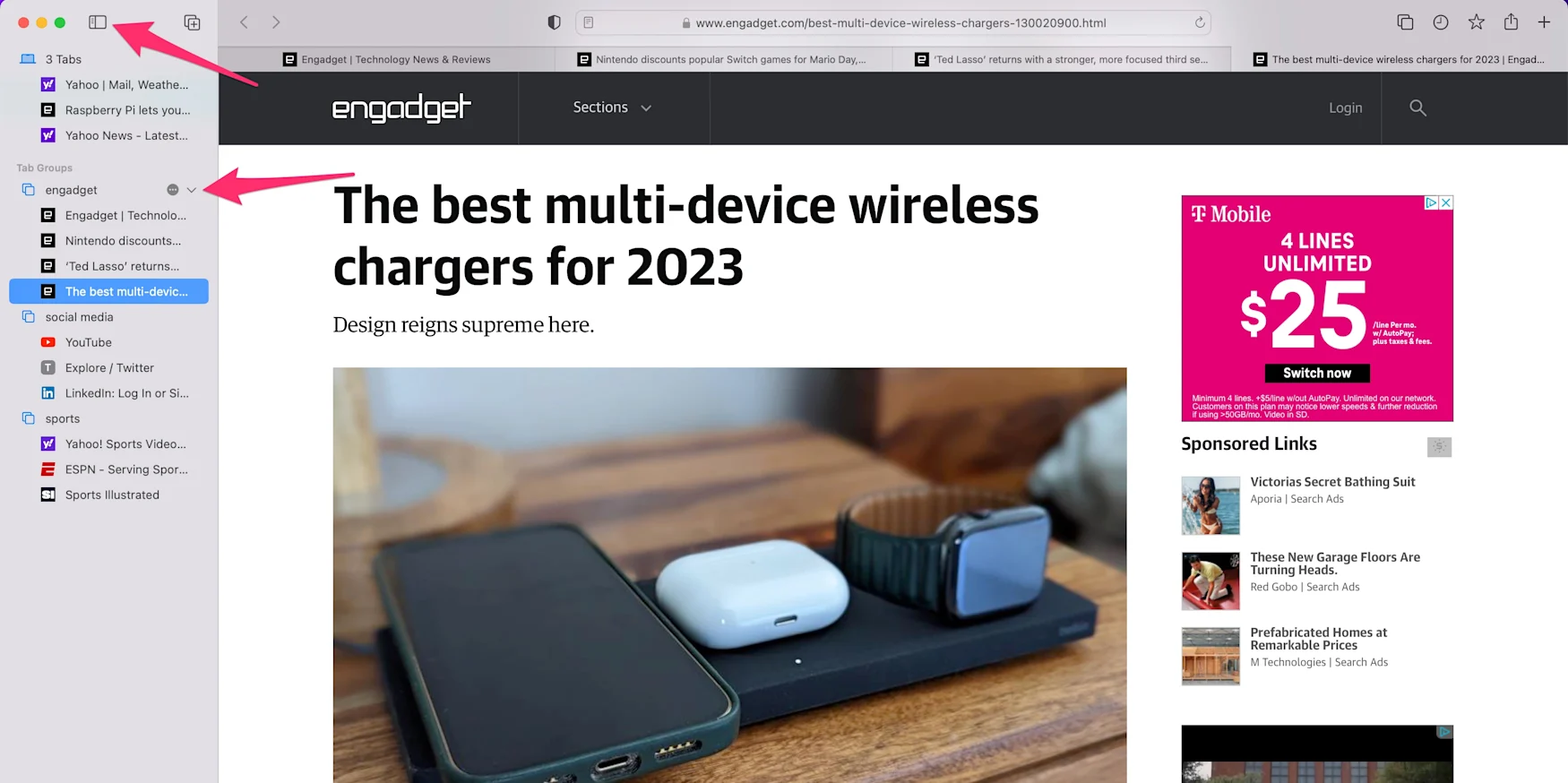
Jeff Dunn / Engadget
To add a new tab to a group, two-finger click the tab, select Move to Tab Group, then choose where you want it to go. If the Sidebar is open, you can also drag a tab into a group directly. To quickly swap between groups, click on your current group’s name in the top left corner, then select the group you want from the resulting dropdown menu. These tab collections will sync across multiple Apple devices if they’re connected to the same iCloud account.
The Sidebar can work somewhat like the vertical tabs view that’s available in Edge. If you hover over “# Tabs” at the top of the Sidebar or the name of any tab group, you’ll see a rightward-facing arrow. Click that, and you’ll see a vertical list of all the tabs nested within. You can access similar views for your bookmarks or Reading List at the bottom of the Sidebar. Safari doesn’t let you hide the horizontal tab bar like Edge, however.

Jeff Dunn / Engadget
Annoyingly, Safari doesn’t allow you to select and drag multiple tabs at once from the tab bar, so separating a chunk of tabs into separate windows can feel clunky. You can easily sort your tabs, however, by two-finger clicking one (or opening the Window menu), then choosing Arrange Tabs By. From here, you can reorganize all your current tabs by their page title or website.
To more comfortably see what tabs you have open, click the Tab Overview icon, which looks like two overlapping squares in the top right corner. This presents all your tabs in a grid as large thumbnails, which can make it easier to find a particular page. You can also get to this page by selecting View > Show Tab Overview, pressing Cmd + Shift + on your keyboard, or two-finger clicking on a tab group in the Sidebar.
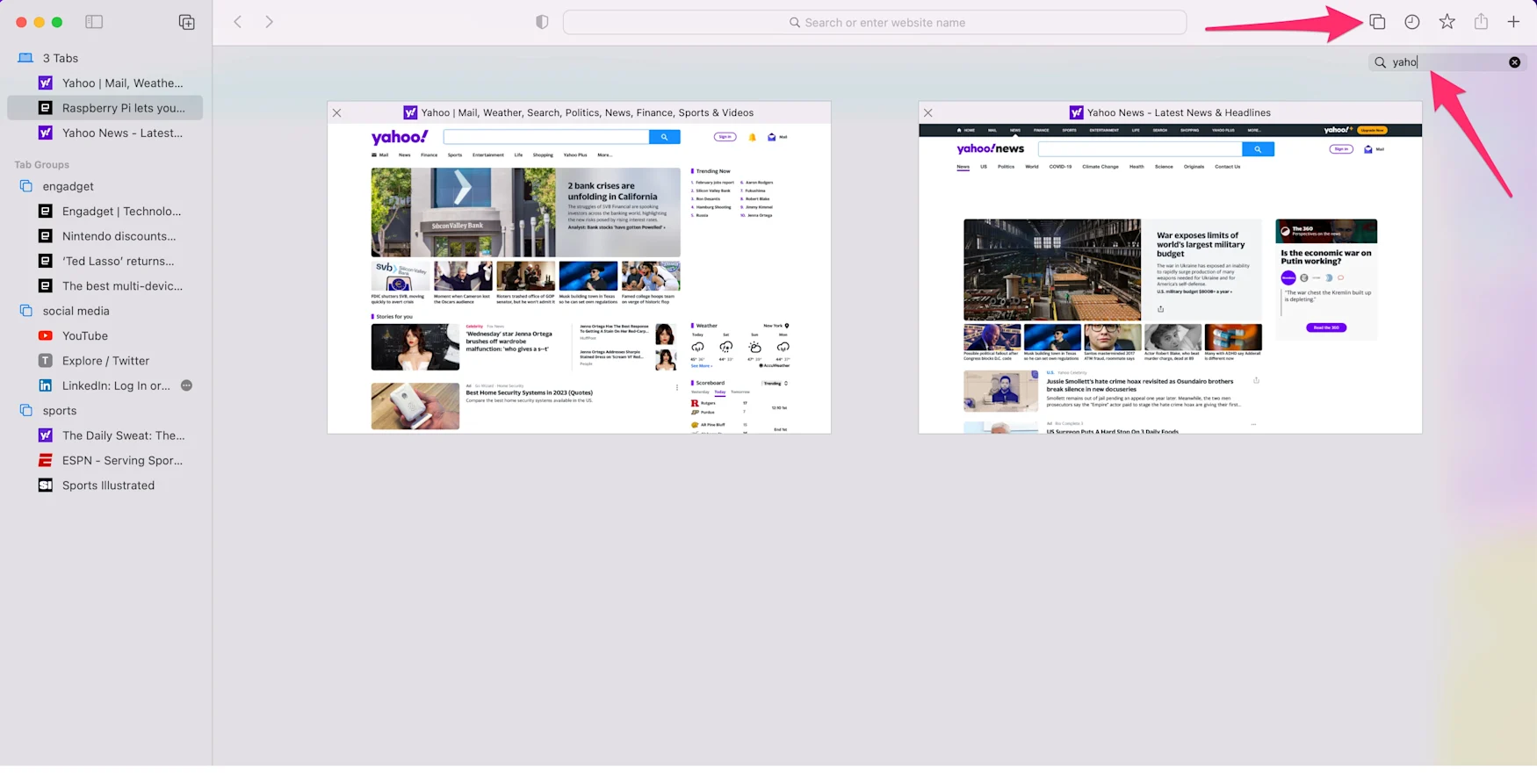
Jeff Dunn / Engadget
In the top right corner of this Tab Overview screen is a search bar. This function is also available on iPhones and iPads. The downside is this search will be limited to just the tabs in your current group, not those in separate tab groups or windows. Simply typing a keyword in the address bar will usually suggest a few relevant tabs you have open, too, but this isn’t comprehensive.
For sites you plan to revisit regularly, you can bookmark a tab by hitting Cmd + D, or going to Bookmarks > Add Bookmark. To bookmark multiple open tabs, select Bookmarks > Add Bookmarks for These # Tabs.
Many of these tricks are also available on Safari for iPhone and iPad. To create a tab group on an iPhone, hit the Tab Overview button, touch and hold a tab, then choose Move to Tab Group. Alternatively, just long-press the address bar while viewing a web page. To look through your tab groups or add all your open tabs to a group by tapping the downward-facing arrow at the bottom of the Tab Overview screen (or top right on an iPad).
How to organize tabs in Firefox

Jeff Dunn / Engadget
Mozilla’s Firefox isn’t as popular as it used to be, but it remains worthwhile if you care strongly about data privacy, customization and independence from the usual tech giants. That said, its native tab management tools aren’t as robust as those in Chrome, Edge or Safari. There are many extensions you can add to close the gap – we’ve noted a few below – but by default, there’s no tab grouping feature, custom window names or vertical tabs mode.
You can still see a tidy list of each window’s tabs, however, by clicking the “List all tabs” button, which is the downward-facing arrow in the top right corner. Above that list you can also access a tab search function. If that’s too cumbersome, typing a relevant keyword in the address bar will display any corresponding open tabs at the bottom of the dropdown list that pops up. Alternatively, you can put a % symbol before or after a keyword search in the address bar to limit your search to just your currently active tabs.
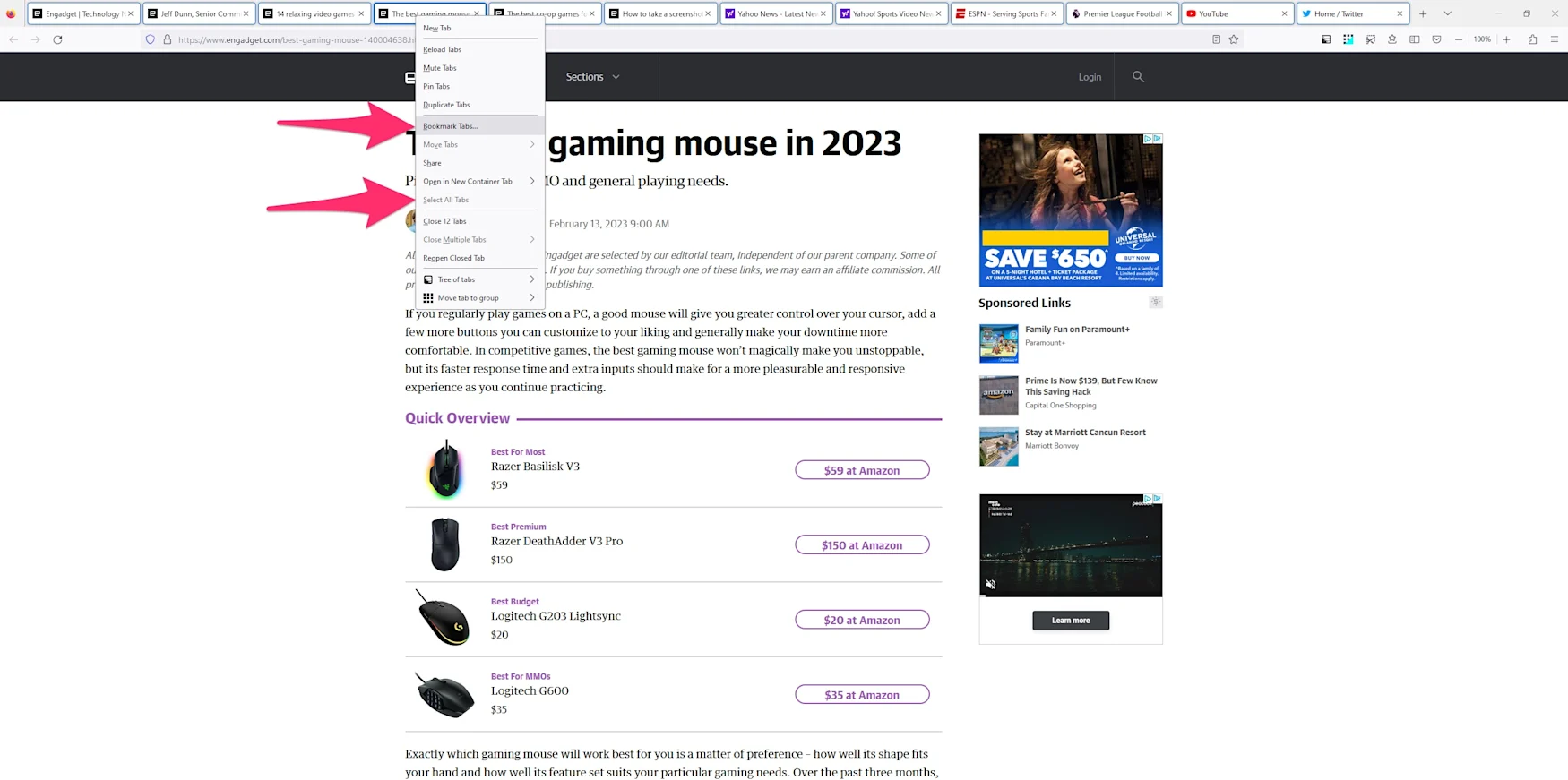
Jeff Dunn / Engadget
As with most browsers, Firefox lets you pin tabs, create bookmarks, close several tabs at once and drag multiple tabs into new windows simultaneously. To put all your current tabs into a bookmark folder, right-click on any tab, choose “Select All Tabs,” right-click again and choose “Bookmark Tabs.”
To open all bookmarked tabs in a folder, go to your bookmarks menu or bookmarks toolbar (depending on where it’s saved), right-click, then select “Open All Bookmarks.” If you want to search for a specific bookmark, put a * symbol before or after a keyword query in the address bar to limit a search to solely your bookmarks.

Jeff Dunn / Engadget
For a little extra organization, note that Firefox also lets you assign custom tags to your bookmarks. You can add these in the menu that pops up whenever you click the star icon for a specific web page, or by clicking Ctrl/Cmd + Shift + O to bring up your full bookmarks library then adding tags as needed. You can also get to the latter by hitting the three-line menu button on the right side, then selecting Bookmarks > Manage Bookmarks.
After setting this up, you can look for a bookmark just by typing out the tag(s) in the address bar. You can also make it so a search in the address bar only pulls from bookmarks you’ve tagged by adding a + symbol.
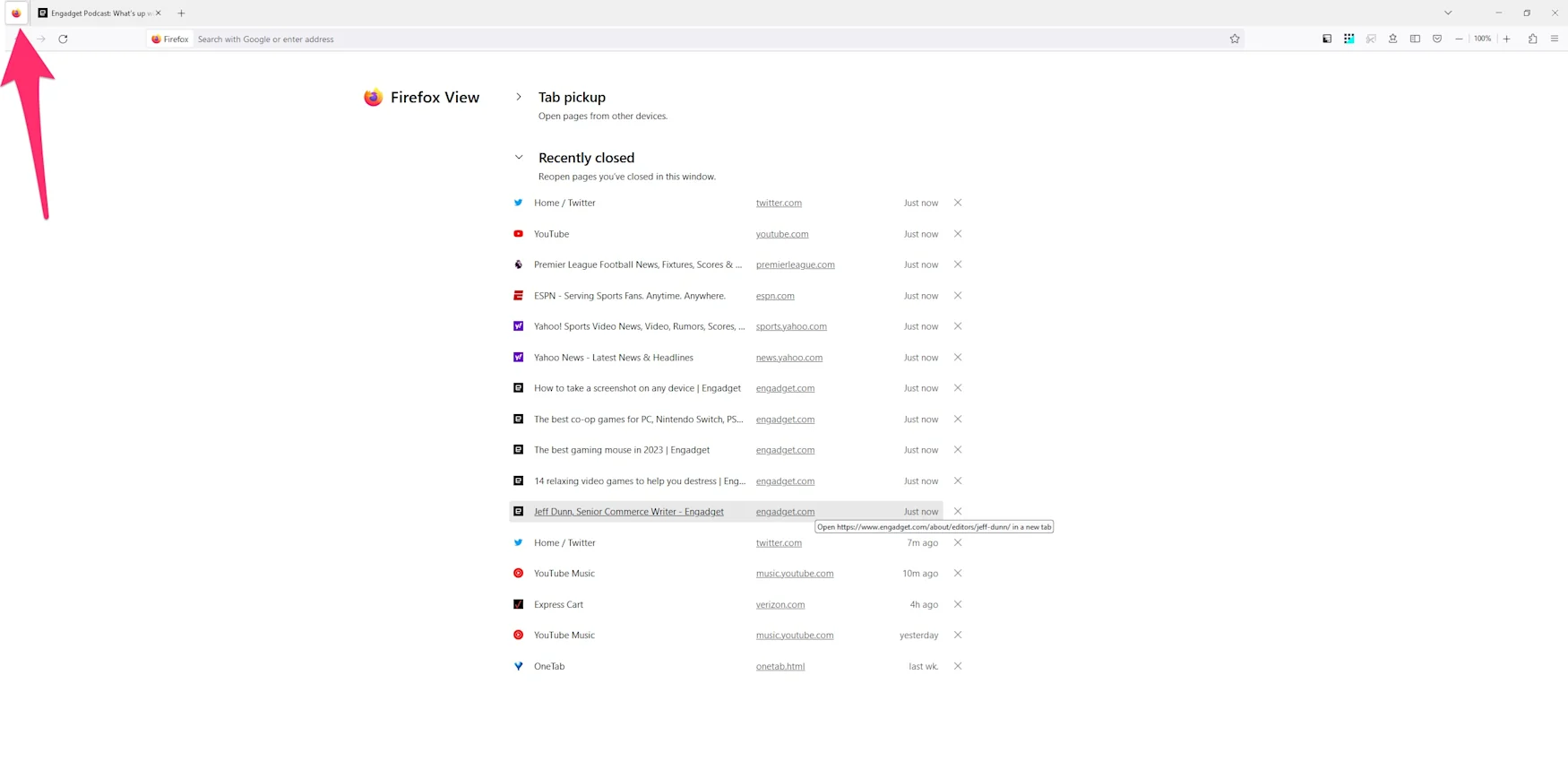
Jeff Dunn / Engadget
You can see a clean-looking list of several recently closed tabs on the Firefox View page. To access this, just click the little Firefox logo pinned in the top left corner. It’s still possible to reopen your last closed tab with the usual Ctrl/Cmd + Shift + T shortcut as well.
Finally, we’ll also make note of Firefox’s “Containers” feature. This is aimed more at privacy than reducing tab clutter: The idea is to separate your browser cookies between distinct clusters of tabs, so you can log into multiple accounts for one website in the same window, or make it so a site can’t see any information about tabs outside of its specific container. Using containers distinguishes your tabs by different color codes, though, which gives it a modicum of organizational value.
You’ll need to install this as an extension on macOS, but once it’s set, you can add one or more tabs to a container by right-clicking it, selecting “Open in New Container Tab,” then choosing the container you want. There are four presets by default; to create a new container, click the three-line menu button and select Settings. Then, look for the Tabs submenu, click the “Settings…” button next to “Enable Container Tabs,” click “Add New Container,” then choose the name, color and icon you want.
Third-party tab extensions
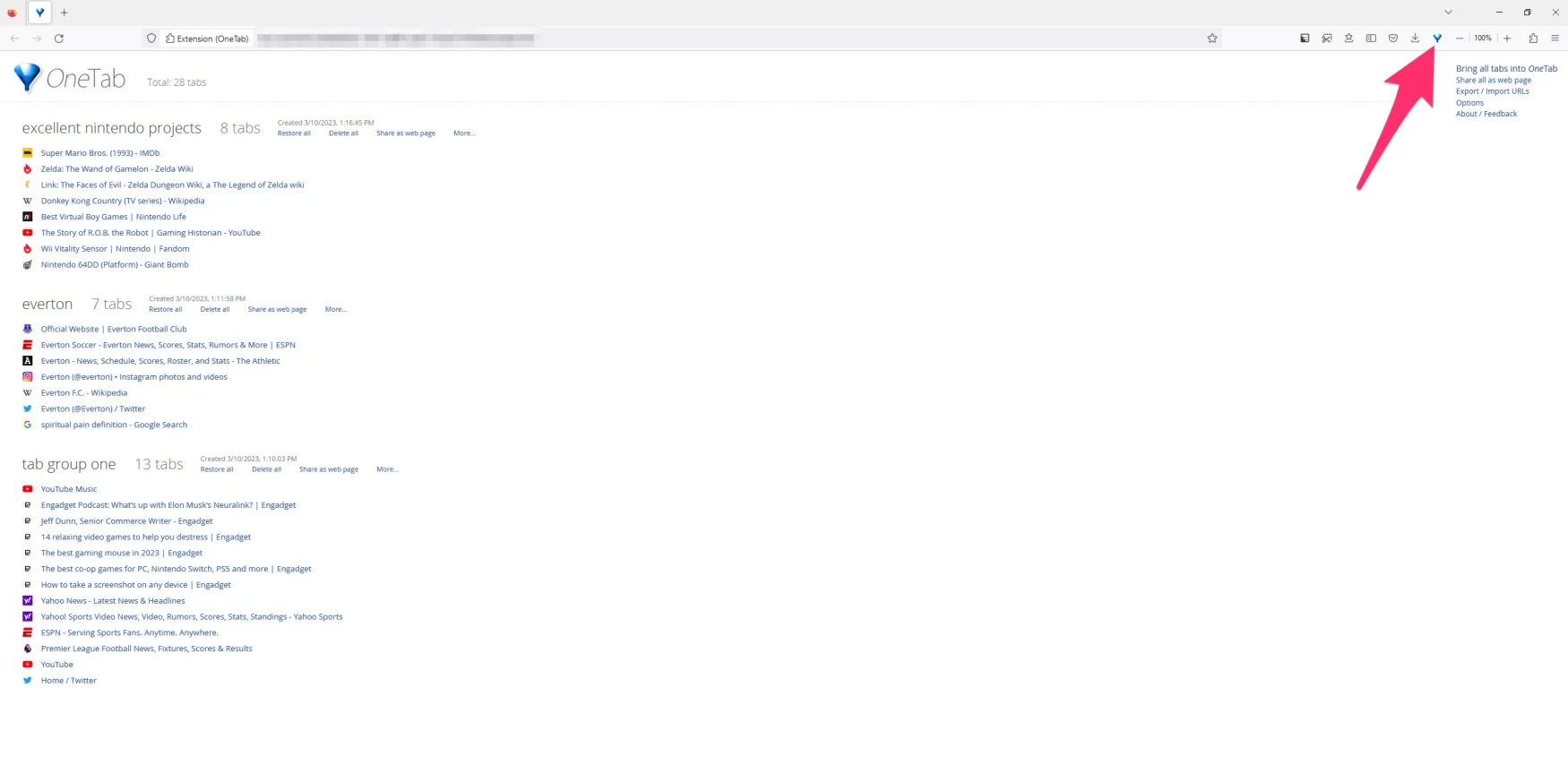
Jeff Dunn / Engadget
All of these built-in browser tools should make navigating tab hell a little more manageable, but if you’re still not quite getting what you need, there are tons of third-party extensions and add-ons that can help. Perhaps the most popular is OneTab, which is available for Firefox, Chrome, Edge and Safari. This adds a little icon by your address bar that, when pressed, quickly collapses all open, non-pinned tabs in your window into an orderly list of links on a separate page. From there, you can then open and delete tabs individually or all at once, drag them into different groups of links you’ve previously OneTab’d, or turn a list of links into one shareable URL. There are other add-ons along these lines, but OneTab is clean, fast and dead simple to use. Plus, it can help make your browser a bit less of a memory hog.
Tab Session Manager for Firefox, Chrome and Edge works similarly. It saves all of your open tabs at once, regardless of whether they’re in different windows. It doesn’t close your tabs; instead they’re displayed as a vertical list in a dropdown menu. You can add tags to specific clusters of tabs, sync “sessions” between devices, and search for tabs right from its menu. You can also access tabs from windows you’ve closed.
Firefox users can particularly benefit from tab managing add-ons. Tree Style Tab, for instance, adds a detailed vertical tabs view, while Window Titler lets you add custom tags to windows. And Simple Tab Groups may not be quite as intuitive as the built-in tab grouping tools built into Chrome, Edge or Safari, but it still provides that sort of functionality in Firefox.

